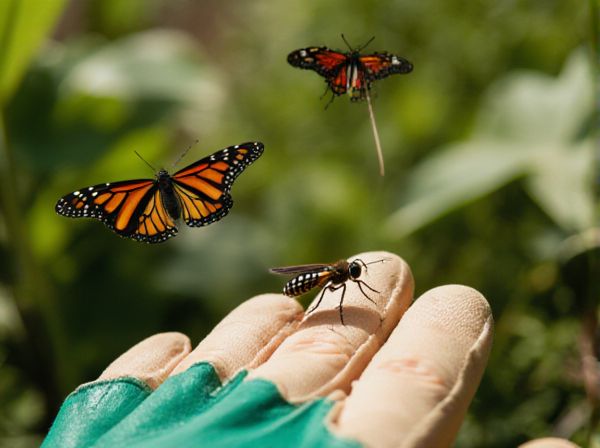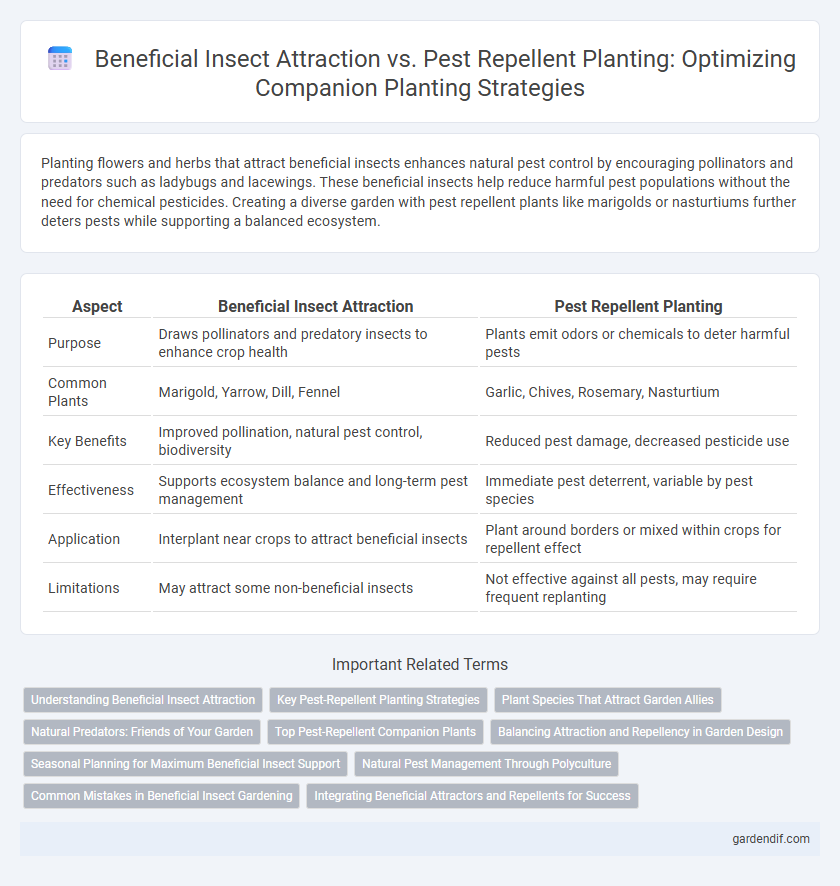
Beneficial insect attraction vs pest repellent planting Illustration
Planting flowers and herbs that attract beneficial insects enhances natural pest control by encouraging pollinators and predators such as ladybugs and lacewings. These beneficial insects help reduce harmful pest populations without the need for chemical pesticides. Creating a diverse garden with pest repellent plants like marigolds or nasturtiums further deters pests while supporting a balanced ecosystem.
Table of Comparison
| Aspect | Beneficial Insect Attraction | Pest Repellent Planting |
|---|---|---|
| Purpose | Draws pollinators and predatory insects to enhance crop health | Plants emit odors or chemicals to deter harmful pests |
| Common Plants | Marigold, Yarrow, Dill, Fennel | Garlic, Chives, Rosemary, Nasturtium |
| Key Benefits | Improved pollination, natural pest control, biodiversity | Reduced pest damage, decreased pesticide use |
| Effectiveness | Supports ecosystem balance and long-term pest management | Immediate pest deterrent, variable by pest species |
| Application | Interplant near crops to attract beneficial insects | Plant around borders or mixed within crops for repellent effect |
| Limitations | May attract some non-beneficial insects | Not effective against all pests, may require frequent replanting |
Understanding Beneficial Insect Attraction
Beneficial insect attraction relies on selecting plants that provide nectar, pollen, and habitat to predators and pollinators essential for natural pest control. Flowering species such as marigolds, daisies, and fennel boost populations of ladybugs, lacewings, and parasitic wasps, enhancing ecosystem balance. Understanding these plant-insect relationships improves garden health by reducing reliance on chemical pesticides through effective biological pest management.
Key Pest-Repellent Planting Strategies
Key pest-repellent planting strategies involve selecting specific plant species such as marigolds, basil, and garlic, which emit natural chemicals to deter harmful insects while attracting beneficial predators like ladybugs and lacewings. Strategic intercropping and trap cropping create physical and chemical barriers that reduce pest colonization, enhancing overall crop health and yield stability. Utilizing diverse polycultures and timed planting cycles further disrupts pest life cycles, minimizing infestations and lowering reliance on synthetic pesticides.
Plant Species That Attract Garden Allies
Marigolds, nasturtiums, and dill are prime examples of plant species that attract beneficial insects such as ladybugs, lacewings, and parasitic wasps, which naturally control pest populations in the garden. Incorporating these companion plants enhances biological pest management by providing nectar and shelter for garden allies like pollinators and predatory insects. Selecting diverse flowering plants that bloom at different times ensures continuous attraction of beneficial species, promoting a balanced and healthy garden ecosystem.
Natural Predators: Friends of Your Garden
Natural predators such as ladybugs, lacewings, and predatory wasps play a crucial role in companion planting by attracting beneficial insects that suppress pest populations naturally. Planting species like dill, fennel, and yarrow encourages these allies to thrive, enhancing biological control without chemical inputs. This ecological balance fosters a healthier garden ecosystem by reducing harmful pests while supporting pollinators and biodiversity.
Top Pest-Repellent Companion Plants
Top pest-repellent companion plants such as marigolds, nasturtiums, and lavender effectively deter harmful insects, reducing the need for chemical pesticides. These plants emit natural volatile compounds that confuse or repel pests like aphids, whiteflies, and nematodes, protecting nearby crops. Utilizing pest-repellent companion planting supports sustainable gardening by enhancing biodiversity and promoting healthy plant growth.
Balancing Attraction and Repellency in Garden Design
Balancing beneficial insect attraction with pest repellent planting enhances garden health by fostering natural pest control while promoting pollination. Strategic placement of nectar-rich flowers alongside repellent herbs creates a micro-ecosystem that supports predators like ladybugs and lacewings, reducing chemical pesticide reliance. Integrating diverse companion plants such as marigolds, basil, and dill optimizes both attraction and repellency, resulting in sustainable and productive garden ecosystems.
Seasonal Planning for Maximum Beneficial Insect Support
Seasonal planning for companion planting maximizes beneficial insect attraction by aligning bloom cycles of nectar-rich plants with key pest activity periods, ensuring continuous support for natural predators. Selecting flowering plants like alyssum and calendula during early spring encourages pollinators and predatory wasps, while late-season blooms sustain beneficial beetles and lacewings. Timely rotation and interplanting of pest-repellent species such as marigolds and garlic further bolster garden resilience by reducing pest populations throughout the growing season.
Natural Pest Management Through Polyculture
Natural pest management through polyculture leverages beneficial insect attraction and pest repellent planting to create a balanced ecosystem that reduces reliance on chemical pesticides. Plants like marigolds, nasturtiums, and dill attract predatory insects such as ladybugs and parasitic wasps, which naturally control pest populations by feeding on aphids and caterpillars. Incorporating diverse plant species with pest-repellent properties disrupts pest colonization while enhancing crop resilience and biodiversity in the garden.
Common Mistakes in Beneficial Insect Gardening
Planting non-native species or relying solely on one type of beneficial insect can disrupt the ecological balance and reduce garden effectiveness. Overusing pesticides, even organic ones, often harms beneficial insects, negating their pest control benefits. Ignoring the diversity of flowering plants needed to attract a wide range of pollinators and predators limits the garden's resilience against pests.
Integrating Beneficial Attractors and Repellents for Success
Integrating beneficial insect attractors such as flowering plants like alyssum and yarrow with pest-repellent species like marigolds and basil enhances garden health by promoting natural pest control. This strategic planting approach supports predatory insects like ladybugs and parasitic wasps while deterring harmful pests including aphids and whiteflies. Combining attractors and repellents creates a balanced ecosystem, reducing the need for chemical interventions and improving overall crop yield.
Beneficial insect attraction vs pest repellent planting Infographic

 gardendif.com
gardendif.com